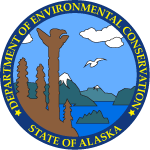| Action Date |
Action |
Description |
DEC Staff |
| 6/12/1991 |
Update or Other Action |
June 12, 1991 RCRA HW Management Compliance Evaluation Inspection Report documents Tim Law, Daniel Hartung, Vic Vickaryous, Geoffrey Kany, of ADEC's RCRA program inspection the Post for compliance with the provisions of the compliance agreement (FFCA) on April 29, April 30, 1991.
Building 704 - DEH Vehicle Storage
Mr. Travis Barber, the foreman of the DEH Vehicle Storage building, was not present during the inspection to escort the inspection team through Building 704. No hazardous waste accumulation was observed when the inspection team quickly walked through the building with Ms. Scott.
Hazardous Waste Drum Storage Yard Adjacent to Bldg. 704
The vast majority of wastes observed during a June 1989 CEI and 1990 inspection have been removed from this one particular unit. Most of the wastes have been merely been transferred to Bldg. 45-133 and essentially all of the containers that went to it have not had adequate hazardous waste determinations made on them, but at least they are in the interim status container storage unit with a containment system, instead of being strewn about at this uncontrolled hazardous waste site. It appears as though the facility is attempting to begin to manage these containers.
There is still visual evidence of release of hazardous constituents (fuel and paint stains) from this regulated unit to the soil. Ms. Catherine Scott (ARMY) stated that AEHA "will be here this summer" to determine the extent of contamination.
A black dented 55-gallon container was considered to be a container of hazardous waste. This hazardous waste also has not had a completely adequate hazardous waste determination made on it yet. This is in violation of 40 CFR 262.11 and Paragraph 21.A. of the FFCA. The presence of this black 55 gallon container in this drum yard also means that Fort Richardson has continued to use this yard for the container storage of hazardous waste, in violation of 40 CFR 262.34(b) and Paragraph 21.J. of the FFCA. Nor has the facility labeled this container as "hazardous waste" in violation of the FFCA. Nor has the facility marked the container with the accumulation start date, in violation of 40 CFR 262.34(a) (2) and Paragraph 21.D. of the FFCA. Nor was the container in good condition, in violation of 40 CFR 265.171, 18 AAC 62.410(2), and Paragraph 21.F. of the FFCA. The 60 day extension opportunity of Paragraph 22.K. of the FFCA is not applicable to Paragraph 22.J. for the black drum, since the contents of the black drum were not sampled for lab analysis. |
Tim Law |
| 12/31/1992 |
Update or Other Action |
RCRA Closure Status Building 704
History/Summary of Closure-Approximately 190 containers, ranging in capacity from 1 to 85 gallons, were stored in the northeast portion of the parking lot surrounding Building 704. Upon discovering this condition, the EPA issued a Notice of Noncompliance (Docket No. 1090-05-29-6001). As a result, the site must undergo a RCRA closure/post closure procedure.
The drums at the site were sampled by the USAEHA from October 10-12, 1990 and results of the sampling were received in three separate memoranda from the USAEHA dated March 6, March 25, and May 14, 1991. Of the 190 containers, three were found to contain oil-soaked rags; two contained soil; three contained solids that could not be sampled with the available equipment; and nine drums of aviation fuel. The remaining drums contained single or two-phase liquids. None of the drums appeared to be leaking.
Analytical results detecected no PCBs although many of the barrels were found to contain hazardous wastes. Two tables on the following pages list the Contaminants of Concern (COCs) and their quantity. In April, 1991, all containers were removed from the site and turned into DRMO where they were subsequently properly disposed. ENSR was contracted to perform the closure plan for this site. Their initial closure draft was submitted to the EPA in Dec. 1992 and we are currently awaiting the EPA's reply.
Costs Associated With This Closure
SAMPLING-Ground samples to determine the Contaminates of Concern (COCS) need to be acquired (the COCs for this site are listed in the table on the following page). ENSR suggests 16 soil samples are needed and will require two samples: a surface sample (approximately six inches deep) and a subsurface sample (approximately two feet deep). Sample collection and handling will be in accordance with EPA Guideline SW-846, Volume II, Chapter 9.
POTENTIAL COSTS-If the area is found to be contaminated, an estimated 669 cu. yd. of soil will need excavated from the site and be . properly disposed. Further sampling will then need to occur and the possibility of ground water monitoring would have to be considered. |
Louis Howard |
| 9/21/1993 |
Update or Other Action |
A.G. letter (Breck Tostevin) to Tamela J. Tobia OS Judge Advocate for the Army. Letter states that a separate petroleum site compliance agreement should be separate from the CERCLA federal facility agreement. The petroleum site restoration agreement would function as a "two-party agreement" under the FFA. It would track the basic provisions of the UST Agreement but be tailored to the State's contaminated site regulations and would interface with the FFA. All petroleum sites addressed under the Two Party agreement would be reviewed in the final operable unit of the FFA and actions taken would be memorialized in a Record of Decision (ROD) under the FFA. |
Louis Howard |
| 11/3/1994 |
Update or Other Action |
January 1998 site transferred from original listing by the federal facility agreement under CERCLA. It had a preliminary source evaluation conducted which lead to no further action under CERCLA but further action under the State-Fort Richardson Environmental Restoration Agreement signed by ADEC and U.S. Army for petroleum releases regulated by the State of Alaska and typically exempt from CERCLA oversight. Purpose of the agreement is to remedy environmental contamination due to past practices at the Post and avoid the expense of formal enforcement proceedings. The Army agrees to perform the necessary assessment, monitoring, remediation and closure of source areas not from underground storage tanks. |
Louis Howard |
| 11/3/1994 |
Meeting or Teleconference Held |
FFA Meeting notes for OUD.
Buildinq 35-752
Former Drum Storaqe Area
8 shallow borings have been completed with samples from 6 inches and 2 feet below ground
surface (bgs). Based on preliminary results 2-20 foot soil borings have been located.
Preliminary results had high levels of TPH and DRO from soil boring #5. Soil boring #8 had
hits of some SVOCs at 6 inches bgs not identified in the other samples. The 2-20 soil borings are scheduled to be advanced today.
Coolinq Ponds
Not sampled yet. [8 sediment samples. 1 angled soil boring from beneath pond sediment. 3 borings completed as monitoring wells. Sample 3 new and 2 existing monitoring wells.]
Concrete Floor
Not sampled yet. [27 wipe samples.]
Backfill Soils in Former USTs Location
4-20 foot soil borings advanced. Scheduled to be completed today. [2 monitoring wells yet to be sampled.]
Stormwater Outfall to Ship Creek
Not sampled yet.
Buildinq 7OO/718
8 shallow borings have been completed with samples from 6 inches and 2 feet below ground
surface (bgs). Preliminary analytical results have been received and will be evaluated today.
Based on the preliminary results 2-20 foot soil borings will be located. One soil boring had a strong petroleum odor throughout.
Buildinq 704
8 shallow borings have been completed with samples from .6 inches and 2 feet below ground
surface (bgs). Preliminary analytical results have been received and will be evaluated today.
Based on the preliminary results 2-20 foot soil borings will be located. One soil boring had some petroleum odor at 2 feet bgs.
Buildinq 796
2 soil borings located inside the building. One was advanced from 2.5 to 3 feet bgs and one
was advanced to about 4 feet bgs. These borings were planned to be 20 feet bgs but because
of height restraints inside the building had to be advanced with hand methods. The samples
were collected from below the anticipated level of former piping connections. Samples from 2-20 foot soil borings have been collected outside the building. Significant soil staining was encountered at approximately 14 to 16 feet bgs from the boring located at the former septic crib. Preliminary laboratory analysis is still pending. Based on the preliminary laboratory analysis, 1 monitoring well will be installed.
Buildinq 955
4-20 foot soil borings have been advanced at this location. One of the soil borings had definite
indication of petroleum contamination. Sampling activities are completed at this site.
Dust Palliative
Sampling at the dust palliative locations is completed. 3 composite samples have been collected form each of the 4 dust palliative locations.
Fire Trainins Area
10 shallow samples have collected from the Fire Training Area. Preliminary analytical results
have yet to be received. Based on the preliminary results 3-20 foot soil borings will be located. l-20 foot soil boring will be located outside the Fire Training Area.
The majority of the samples had a strong petroleum odor. Field PID readings were high; one
at 2,500 units. A second Fire Training Area has been identified.
Grease Pits
One of the two grease pits identified in the Work Plan has been located with a good degree of
reliability. The location of the second grease pit is confused because several pits have been
located in the area. All the pits in the area have since been identified as human waste (sewage disposal) pits. No sampling has occurred at this site.
Backsround Samplinq
1 shallow boring and l-20 foot soil boring has been sampled from each of the 4 background
locations. Sampling activities are completed at these sites.
|
Louis Howard |
| 10/1/1995 |
Site Characterization Report Approved |
Preliminary Source Evaluation (PSE 2) Operable Unit D report shows that 8 surface soil samples and two 20' soil borings done at site to identify any potential contamination. Maximum detected concentrations did not exceed EPA's region III Risk base concentrations using the most conservative residential land use scenario. DRO maximum detected concentration 1,454 mg/kg and no other COCs for petroleum exceed the level "A" criteria. Site to be transferred to SFRERA NON-UST agreement. |
Louis Howard |
| 2/17/1997 |
Site Added to Database |
Soil contaminated with diesel range organics. |
Louis Howard |
| 12/2/1997 |
Site Ranked Using the AHRM |
Site ranked by staff. |
Louis Howard |
| 1/14/1998 |
Update or Other Action |
Transferred from CERCLA OU D to State-Ft. Richardson Environmental Restoration Agreement by 3 RPMs from U.S. EPA, U.S. Army, and ADEC. DRO is the only contaminant of concern so no further action under CERCLA is required. |
Louis Howard |
| 1/14/1998 |
Site Closure Approved |
Site did not exceed level D criteria for DRO (2000 mg/kg) and site closure granted. However, site is still considered "open" under the 1991 Federal Facility Compliance Agreement (RCRA) for site closure plans.
The following policy applies for soil regulated under 18 AAC 75 and 18 AAC 78 that is proposed for disposal off site from where it was generated. If the following criteria is met, ADEC approval and/or an institutional control(s) are not required:
1. The soil meets the most stringent Method Two, Migration to Groundwater, Table B2 cleanup level, and the most stringent standards for those chemicals under Table B1;
2. The soil may only be disposed of at any non-environmentally sensitive location in the Under 40" or Over 40" annual precipitation zone;
3. The soil is not placed within 100 feet of water wells, surface waters, and drainage ditches; and
4.The written approval from the landowner of the off-site location is required.
The off site disposal of all other soil subject to the site cleanup rules that does not meet the criteria above shall be reviewed by the ADEC project manager in order to determine if the off-site disposal action poses a current or future risk to human health or the environment. The final approval to dispose of soil off site that does not meet the criteria shall be made by the ADEC Section Manager.
Terms used in this document have the meaning given in 18 AAC 75.990 including: “environmentally sensitive area” means a geographic area that, in the department's determination, is especially sensitive to change or alteration, including:
(A) an area of unique, scarce, fragile, or vulnerable natural habitat;
(B) an area of high natural productivity or essential habitat for living organisms;
(C) an area of unique geologic or topographic significance that is susceptible to a discharge;
(D) an area needed to protect, maintain, or replenish land or resources, including floodplains, aquifer recharge areas, beaches, and offshore sand deposits;
(E) a state or federal critical habitat, refuge, park, wilderness area, or other designated park, refuge, or preserve; and
(F) an area that merits special attention as defined at 6 AAC 80.170 (Repealed see AS 46.40.210(1))
“area which merits special attention” means a delineated geographic area within the coastal area which is sensitive to change or alteration and which, because of plans or commitments or because a claim on the resources within the area delineated would preclude subsequent use of the resources to a conflicting or incompatible use, warrants special management attention, or which, because of its value to the general public, should be identified for current or future planning, protection, or acquisition; these areas, subject to council definition of criteria for their identification, include:
(A) areas of unique, scarce, fragile or vulnerable natural habitat, cultural value, historical significance, or scenic importance;
(B) areas of high natural productivity or essential habitat for living resources;
(C) areas of substantial recreational value or opportunity;
(D) areas where development of facilities is dependent upon the utilization of, or access to, coastal water;
(E) areas of unique geologic or topographic significance which are susceptible to industrial or commercial development;
(F) areas of significant hazard due to storms, slides, floods, erosion, or settlement; and
(G) areas needed to protect, maintain, or replenish coastal land or resources, including coastal flood plains, aquifer recharge areas, beaches, and offshore sand deposits. |
Louis Howard |
| 9/28/2000 |
Update or Other Action |
OUD ROD signed. Originally part of the 12 source areas for OUD. ROD signature memorializes the no further action decision for the site. The only petroleum contaminants were detected at the source area so it was determined no further action under CERCLA was necessary and transferred to the NON-UST Two Party Agreement. All sampling results obtained at the source area indicated it was below the Level D criteria and site was closed out. RCRA closure plans for the 1991 FFCA were developed for the solid waste management unit and submitted to EPA. Final closure plan that incorporated comments and recommendations from EPA and ADEC were submitted on February 4, 1994 for the site. |
Louis Howard |
| 2/22/2001 |
Update or Other Action |
EPA provided comments on RCRA closure under the 1991 Fort Richardson FFCA which requires USARAK to determine whether hazardous wastes were stored or released from this unit. Site was used as a drum staging area from 50s to 1991. All drums were removed in 1991. Established cleanup level for site is 2000 mg/kg DRO. Maximum level detected was 1,454 mg/kg DRO so unit is considered clean closed under RCRA and the FFCA. |
Louis Howard |
| 8/29/2007 |
GIS Position Updated |
61.2581 latitude N -149.7087 W longitude |
Louis Howard |




